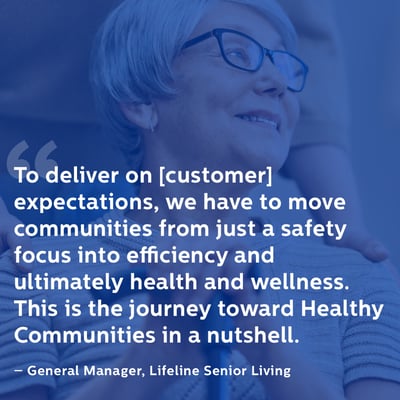Starting with the familiar—the overall goal of senior care will not change. Operators will still be dedicated to providing the best quality of life to everyone in our communities. But how we define ‘best quality of life possible’ is going to evolve as families will be expecting more frequent, and higher quality access to their loved ones. They’ll also expect more frequent communication from the community—similar to the level of contact that became the norm during the pandemic. Residents, too, will expect more from their communities—in both services and care.
From the standpoint of continuing challenges, communities will likely face the ever-present demand to do more with less. Residents and families are going to demand more contact, more information and more convenient touch points. And these increasing demands will need to be met without a dramatic (or if any) increase in staffing.
And then there are the new concerns—including how to integrate seniors who are used to constant internet access, how to manage future pandemics, and how best to improve the overall level of care.
All of these challenges can be met, but it will require some new tools and a new way of thinking about the health of your community.
The idea of 'Healthy Communities'

While the idea of a safe community is familiar, the notion of a Healthy Community is likely less so. The term stems from a desire to move toward considering each resident’s overall well-being—as opposed to focusing primarily on safety. It’s a differentiated, next generation community designed to deliver a better community experience.
In a Healthy Community, residents have more interaction and entertainment options, staff have a clearer picture of where residents are and what they need, and families have real insights into what their loved ones are doing every day.
“Within the next decade, there will be a dramatic shift in customer demands of senior living communities: away from nursing and end of life care, and towards vibrant health and wellness communities,” says Kim Judd, General Manager, Lifeline Senior Living. “To deliver on these expectations, we have to move communities from just a safety focus into efficiency and ultimately health and wellness. This is the journey toward Healthy Communities in a nutshell.”
This won’t be an immediate change, however. Getting there is an adaptive journey, focused on maintaining a safe community and evolving more toward efficiency, and ultimately health and wellness. And since communities aren’t likely to receive more money, resources or staff, technology is a critical part of this transition.
The role of technology
The Healthy Community model requires the adoption of ‘advanced technology’ designed to transform community operations and enhance overall resident care.
“By ‘advanced technology,’ we mean a next generation resident safety and community management system that utilizes cloud-based, real-time location technology, or RTLS, which analyzes staff and resident movements in real time and captures them with data derived from Bluetooth and other wearable devices,” explains Judd.
Cloud-based, RTLS systems are the bridge from an older era of traditional pull cord and pendant technology, she says. “It’s what we expect will become the new normal: a digital platform with rich-data and increasingly powerful tools and analytics.”
Advanced functionality of a next gen system delivers a host of analytic and reporting features that provide deep insights into the health of a community during a crisis.
Mitigating factor: the role of architecture in Healthy Communities
The idea of a Healthy Community is a holistic way to look at how a facility operates. As such, architecture can play a crucial role in creating a space where residents can thrive. In fact, researchers have found that there is a connection to properly designed spaces, and residents' perceptions of their own wellness.
The design of buildings and campuses can focus on managing entry points, providing secure space for testing during outbreaks, creating safe outdoor spaces to encourage interaction, planning for co-horting options that will create smaller sub-communities, and implementing Building Automation Systems to monitor and control building systems remotely.
A Healthy Community in action
To better envision what a healthy community means, here are a few examples.
- With an improved understanding of staff movement, a facility will be better able to spot inefficiencies related to time spent with residents and time to respond to issues.
- Patient step counts can show which residents aren’t as mobile as they should be—encouraging exercise programs and other interventions.
- The system can allow communities to use proximity data to see which residents may be socially isolated. Read more on resident social isolation
- Movement data can show staff and families how active and engaged a resident is.
- And Keep in/Keep out boundaries through RTLS help to control wandering and limit resident interactions during a community outbreak.
Moving forward with new technologies
“In the near future, tech-savvy (or at the very least tech-familiar) residents will want more exposure to the tech they’re familiar with as they transition to a senior living community. At a minimum, this will increase the demand for community-wide Wi-Fi,” says Judd.
In a grander sense, making this necessary move will provide more opportunities to offer support and entertainment to isolated residents, helping improve their sense of overall wellness. It will also offer the opportunity to bring familiar consumer-focused voice command devices into your facility—opening up amazing opportunities for a more connected, more responsive, more enriching community.
Advanced technology can have a major role to play in a Healthy Community, especially during a viral outbreak:
-Personalized geo-fence boundaries for quarantines and social distancing
-Heat mapping to assess adherence to infection control protocols
-Cloud-based system for remote access to community dashboard
-Historical play back of resident, staff and visitor interactions
Lifeline Senior Living is ready to talk about the future
We spend every day looking toward the future to find innovative ways to improve the lives of seniors. To see how advanced technology can help your community evolve, schedule a demo.

